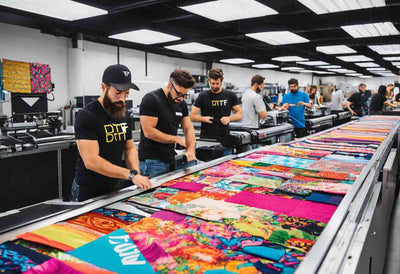Here's an overview:
- Introduction to DTF Transfers
- What Are DTF Transfers?
- The DTF Transfer Process Explained
- Comparing DTF Transfers to Traditional Methods
- Why Choose DTF Transfers for Your Business
- Advantages of DTF Transfers
- Cost-Effectiveness and ROI of DTF Transfers
- Quality and Durability of DTF Transfers
- Customization Opportunities with DTF Transfers
- Environmental Impact of DTF Transfers
- Case Studies: Businesses Thriving with DTF Transfers
- Implementation Tips for DTF Transfers in Your Business
- Common Challenges and How to Overcome Them
- Future Trends in DTF Transfer Technology
- Conclusion: The Future Proof Choice for Your Business
Introduction to DTF Transfers
DTF, or Direct-to-Film, transfers represent a revolutionary technology in the printing industry. Unlike DTG (Direct-to-Garment) printing, DTF transfers involve printing designs onto a special film and then transferring them to the fabric using a heat press. This process allows for enhanced versatility across various fabric types, drastically reducing the limitations faced with traditional methods.
Key DTF resources include:
DTF supplies necessary for this process range from specialized inks to transfer films. Proper understanding of DTF vs DTG printing can offer insights into the distinct advantages that DTF transfers provide.
What Are DTF Transfers?
DTF transfers, or Direct-to-Film transfers, refer to a printing technology that involves applying designs onto garments using specialized film and adhesives. This technology has revolutionized custom printing by offering exceptional detail and vibrant colors. Unlike DTF vs. DTG printing, which prints directly onto the garment, DTF prints first on a film before being transferred.
Essentially, the process involves:
- Printing the design onto a special film using DTF supplies.
- Applying adhesive powder to the printed film.
- Curing the adhesive and design using optimal DTF heat press settings.
For placement, refer to a DTF transfer placement guide.
The DTF Transfer Process Explained
The Direct-to-Film (DTF) transfer process is a critical innovation in the custom printing industry, offering streamlined and versatile printing capabilities. Understanding the DTF meaning in printing is essential.
Key Steps in the DTF Process:
-
Printing:
- A specialized printer uses DTF inks to print designs directly onto a polyethylene terephthalate (PET) film.
- A design software ensures the image is printed in reverse for correct application.
-
Powder Application:
- The printed film is dusted with a hot-melt adhesive powder.
- Excess powder is removed to ensure precision.
-
Curing:
- The film undergoes heating using optimal DTF heat press settings guide to cure the adhesive powder.
- It solidifies the ink and powder onto the film.
-
Transfer:
- Using a DTF transfer placement guide, the film is aligned on the garment.
- Applied with a heat press at recommended settings.
-
Peeling:
- The PET film is peeled off, leaving the design firmly attached.
Comparing DTF Transfers to Traditional Methods
When exploring DTF transfers, consider their efficiency in contrast to traditional methods. Traditional methods often involve screen printing or direct-to-garment (DTG) techniques. DTF transfers offer several advantages:
- Versatility: DTF transfers suit a range of textiles, unlike screen printing which has limitations.
- Preparation Time: Traditional methods like screen printing require extensive setup. DTF transfers are "DTF ready to press", saving time.
- Detail and Quality: DTF transfers can handle intricate designs better than many traditional techniques.
- Supplies Management: DTF supplies are generally simpler and more economical.
- Heat Press Settings: Optimal DTF heat press settings guide ensures consistent quality.
Why Choose DTF Transfers for Your Business
Direct-to-Film (DTF) transfers offer significant advantages that make them a superior choice for businesses. Here's why:
- Versatility: Unlike DTG, DTF transfers can be applied to a wide range of fabrics, including cotton, polyester, and blends.
- Quality: DTF transfers provide vibrant colors and durable prints, ensuring the longevity of your designs.
- Cost-Effectiveness: Using DTF technology reduces wasted materials and labor costs, making it a budget-friendly option.
- Ease of Use: With DTF ready to press processes and comprehensive DTF transfer placement guides, businesses can easily implement this method.
- Efficiency: Follow the optimal DTF heat press settings guide to achieve consistent and high-quality results swiftly.
- Minimal Investment: DTF supplies are generally affordable, requiring less initial investment compared to traditional printing methods.
Advantages of DTF Transfers
Direct-to-Film (DTF) transfers offer several benefits that make them a preferred choice in the printing industry.
- Versatility: Suitable for various fabrics, including cotton, polyester, and blends.
- Durability: High resistance to washing and wear over time.
- Detail and Color: Delivers vibrant details and intricate designs with ease.
- Efficiency: Eliminates the need for pretreatments or elaborate setup.
- Cost-Effective: Reduces costs associated with additional dtf supplies.
- Flexibility: Can easily handle large and small print runs.
- Ease of Use: Simple application process with dtf ready to press designs.
- Guidance: Availability of comprehensive dtf transfer placement guides and optimal dtf heat press settings guides.
Cost-Effectiveness and ROI of DTF Transfers
Direct-to-Film (DTF) transfers offer significant cost-effectiveness and return on investment (ROI) for businesses. Unlike traditional printing methods, DTF allows smaller production runs without the prohibitive setup costs. Lower entry costs make it accessible for both small businesses and large-scale operations.
Key Advantages:
- Lower Capital Investment: Minimal need for expensive equipment sets DTF apart from other methods.
- Flexible Production: Enhanced ability to handle varying project sizes efficiently.
- Reduced Waste: Precise DTF transfer placement guides ensure minimal waste, leveraging dtf ready to press features.
These points illustrate the financial benefits of adopting DTF printing for custom apparel.
Quality and Durability of DTF Transfers
Quality and durability are crucial when evaluating DTF transfers. For those unfamiliar with DTF meaning in printing, it stands for Direct-to-Film, a method that excels in producing high-quality designs.
Major Highlights:
- Longevity: DTF transfers demonstrate exceptional durability, often outlasting traditional screen prints.
- Vibrancy: Colors remain vivid even after multiple washes.
- Versatility: Suitable for various fabrics, including cotton, polyester, and blends.
Key Factors:
- DTF Ready to Press: Ensures ease of use, speeding up production times.
- DTF Supplies: Quality inks and films enhance print longevity.
- Optimal DTF Heat Press Settings Guide: Adherence guarantees top performance.
Comparative Analysis:
- DTF vs DTG Printing Key Differences Explained: DTF offers better resistance to wear and tear.
The DTF Transfer Placement Guide is also intricate, ensuring precise and consistent results.
Customization Opportunities with DTF Transfers
DTF transfers open up a wide range of customization opportunities, making them an essential consideration for any professional in the printing industry. By leveraging DTF (Direct to Film) technology, users can achieve intricate designs and vibrant colors on various textiles.
Key Benefits of Customization with DTF Transfers
- Versatility in Design: From detailed graphics to bold text, DTF transfers can accommodate diverse design needs.
- Color Accuracy: The technology ensures precise color matching and pigmentation.
- Material Compatibility: DTF transfers work effectively on cotton, polyester, blends, and more.
- Durability: Customized prints maintain vibrancy even after multiple washes.
Tools and Guides
- DTF Ready to Press: Essential for quick and efficient application.
- DTF Transfer Placement Guide: Ensures precise and consistent transfer placement.
- Optimal DTF Heat Press Settings Guide: Helps in achieving the best results without damaging materials.
By understanding the DTF meaning in printing, professionals can explore substantial benefits, especially when considering DTF vs. DTG (Direct to Garment) printing. Access to quality DTF supplies is crucial for effective customization.
Environmental Impact of DTF Transfers
DTF printing stands for Direct-to-Film printing, a technique gaining popularity in the printing industry due to its efficiency and environmental advantages. When comparing DTF vs. DTG printing, one notable difference is their respective environmental impacts.
Key Points:
- Reduction in Waste: DTF transfers minimize textile wastage by ensuring accurate placement, adhering to the DTF Transfer Placement Guide.
- Eco-Friendly Supplies: DTF supplies, including ink and films, often strive to meet rigorous environmental standards.
- Energy Efficiency: The optimal DTF heat press settings guide recommends specific temperature and pressure configurations that contribute to energy efficiency.
- Sustainable Practices: Many businesses offering DTF ready-to-press products are adopting sustainable practices, reducing their carbon footprint.
Case Studies: Businesses Thriving with DTF Transfers
1. Apparel Brand A:
- Enhanced design applications with DTF meaning in printing your clear guide
- Streamlined production using DTF ready to press
- Increased profitability by sourcing DTF supplies efficiently
2. Promotional Company B:
- Achieved vibrant prints through DTF vs DTG printing key differences explained
- Utilized the DTF transfer placement guide for precise, high-quality placements
- Optimized workflow with the optimal DTF heat press settings guide
3. Custom Print Shop C:
- Enhanced customer satisfaction by offering detailed descriptions on about us section
- Expanded product range through advanced DTF supplies methods
- Improved design variety with comprehensive DTF ready to press options
These case studies underscore the significant impact of DTF transfers on diverse business models.
Implementation Tips for DTF Transfers in Your Business
Implementing DTF transfers into a business involves understanding various aspects of "dtf ready to press" materials and "dtf supplies." Given the importance, here are practical tips:
-
Understand DTF Meaning: Learn about “dtf meaning in printing your clear guide” to grasp its applications.
-
Placement Guide: Follow a comprehensive "dtf transfer placement guide" to ensure accurate designs.
-
Optimal Heat Press Settings: Utilize an "optimal dtf heat press settings guide" for best results.
-
Compare Printing Methods: Know DTF vs. DTG printing key differences explained to choose the right solution.
-
Supplier Research: Source quality "dtf supplies" from reputable providers.
-
Staff Training: Train employees thoroughly on DTF processes for efficiency and quality assurance.
-
Equipment Maintenance: Regularly maintain DTF heat pressing machines to ensure longevity and performance.
Common Challenges and How to Overcome Them
Placement and Alignment
Poor placement can ruin a print. Utilize a DTF Transfer Placement Guide for precision. Marking the garment and using alignment tools can help achieve consistent results.
Heat Press Settings
Incorrect heat settings can lead to poor adhesion and durability. Consult the Optimal DTF Heat Press Settings Guide to ensure appropriate temperature, pressure, and time.
Sourcing Quality Supplies
Low-quality supplies can result in subpar prints. Choose reputable vendors for DTF Supplies to guarantee consistent, high-quality output.
Design Compatibility
Not all designs are suitable for DTF. Understanding DTF Meaning in Printing and its limitations can guide design choices.
Comparisons with Other Printing Methods
DTF vs DTG Printing Key Differences Explained help in understanding when to choose DTF for specific projects.
Future Trends in DTF Transfer Technology
The future of DTF transfer technology promises numerous advancements and enhancements. Key trends to watch include:
- Automation: More sophisticated machinery will streamline the DTF transfer process, reducing labor and error rates.
- Sustainability: Innovations in eco-friendly inks and recyclable substrates will make DTF printing more sustainable.
- Enhanced Software: Software that integrates with DTF ready to press systems will become more user-friendly, offering advanced editing options.
- Customizability: Growing demand for bespoke products will lead to DTF systems that cater to intricate designs and personalized items.
- Materials Development: New substrates and adhesive formulations that improve adhesion and durability are on the horizon.
Conclusion: The Future Proof Choice for Your Business
Direct-to-Film (DTF) transfers present unparalleled benefits for businesses. Unlike traditional methods, DTF technology offers:
- Versatility in fabric compatibility, from cotton to synthetics.
- Efficiency by minimizing production times, crucial for quick turnarounds.
- Cost-effectiveness due to reduced waste and lower ink consumption.
- Image quality that remains sharp and vibrant, outperforming methods discussed in "DTF vs DTG Printing Key Differences Explained."
With the proper "DTF Supplies" and adherence to the "Optimal DTF Heat Press Settings Guide," businesses can achieve professional results consistently. For detailed steps and visual aids, refer to the "DTF Transfer Placement Guide."





